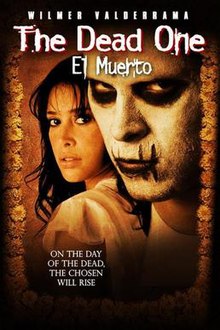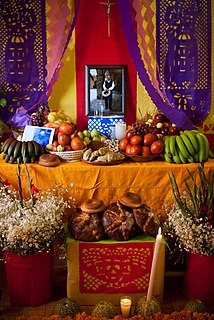
The Day of the Dead is a Mexican holiday celebrated in Mexico and elsewhere associated with the Catholic celebrations of All Saints' Day and All Souls' Day, and is held on November 1 and 2. The multi-day holiday involves family and friends gathering to pray for and to remember friends and family members who have died. It is commonly portrayed as a day of celebration rather than mourning. Mexican academics are divided on whether the festivity has indigenous pre-Hispanic roots or whether it is a 20th-century rebranded version of a Spanish tradition developed by the presidency of Lázaro Cárdenas to encourage Mexican nationalism through an "Aztec" identity. The festivity has become a national symbol and as such is taught in the nation's school system, typically asserting a native origin. In 2008, the tradition was inscribed in the Representative List of the Intangible Cultural Heritage of Humanity by UNESCO.

Aztec mythology is the body or collection of myths of Aztec civilization of Central Mexico. The Aztecs were Nahuatl-speaking groups living in central Mexico and much of their mythology is similar to that of other Mesoamerican cultures. According to legend, the various groups who were to become the Aztecs arrived from the north into the Anahuac valley around Lake Texcoco. The location of this valley and lake of destination is clear – it is the heart of modern Mexico City – but little can be known with certainty about the origin of the Aztec. There are different accounts of their origin. In the myth the ancestors of the Mexica/Aztec came from a place in the north called Aztlan, the last of seven nahuatlacas to make the journey southward, hence their name "Azteca." Other accounts cite their origin in Chicomoztoc, "the place of the seven caves," or at Tamoanchan.
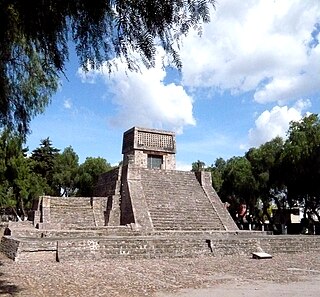
Mictlan is the underworld of Aztec mythology. Most people who die would travel to Mictlan, although other possibilities exist.. Mictlan consists of nine distinct levels.

Mictlāntēcutli or Mictlantecuhtli, in Aztec mythology, is a god of the dead and the king of Mictlan (Chicunauhmictlan), the lowest and northernmost section of the underworld. He is one of the principal gods of the Aztecs and is the most prominent of several gods and goddesses of death and the underworld. The worship of Mictlantecuhtli sometimes involved ritual cannibalism, with human flesh being consumed in and around the temple.

Wilmer Eduardo Valderrama is an American actor, producer, singer, and television personality. He is best known for the role of Fez in the sitcom That '70s Show (1998–2006) and as Carlos Madrigal in From Dusk till Dawn: The Series (2014–16). He was also host of the MTV series Yo Momma (2006–07), the voice of Manny in the children's show Handy Manny (2006–13) and has had recurring roles on Grey's Anatomy as well as The Ranch. He is currently part of the main cast of NCIS, portraying Special Agent Nick Torres.
In the context of creation myths, the term Five Suns describes the doctrine of the Aztec and other Nahua peoples in which the present world was preceded by four other cycles of creation and destruction. It is primarily derived from the mythological, cosmological and eschatological beliefs and traditions of earlier cultures from central Mexico and the Mesoamerican region in general. The Late Postclassic Aztec society inherited many traditions concerning Mesoamerican creation accounts, while however modifying some aspects and supplying novel interpretations of their own.
El Muerto, also known as El Muerto: The Aztec Zombie, is a fictional character and comic book superhero created by American comics creator Javier Hernandez and published through his own imprint Los Comex. The comic book follows the story of 21-year-old Diego de la Muerte, who while on his way to a local Dia de los Muertos festival in Whittier, California, is abducted and sacrificed by the Aztec gods of death and destiny only to return to earth one year later with supernatural powers. The character made his first appearance in a xeroxed black-and-white preview comic titled Daze of the Dead: The Numero Uno Edition. The initial series of El Muerto was met with critical success and the character's popularity has led to several adaptations in other media including a live-action award-winning independent film starring Wilmer Valderrama.
El Muerto is a Spanish term that translates as "The Dead One". It may refer to:
Rafael Navarro is an independent American comic-book artist best known for creating the Xeric Award winning series, Sonambulo, which cleverly blends elements of Lucha Libre and the noir genre. He has collaborated with Keith Rainville and has had work featured in Rainville's From Parts Unknown Publications. Navarro also has experience in storyboarding and has acted as a contributor to several animated television series as Rugrats and ¡Mucha Lucha!. A longtime friend of fellow creator Javier Hernandez, Navarro makes a cameo appearance in the film adaptation of El Muerto: The Aztec Zombie.
Big Umbrella is a defunct comic-book imprint which was formed by indie comic creators Rafael Navarro, Javier Hernandez, Michael Aushenker, Ted Seko, and Rhode Montijo. It wasn't considered an imprint as along the lines of a DC or Marvel imprint but more along the lines of a loosely formed coalition of independent publishers and friends. The imprint disbanded sometime in 2003 due to problems in the market-place. According to creator Javier Hernandez:
...[T]he straw that broke the camel's back, regarding Big Umbrella, was the fact that Diamond, the sole, national comic distributor with an exclusive contract with the national comic books direct market, chose to only carry some of the books.
Michael Aushenker is an independent American comic-book artist and creator based in Los Angeles, California, best known for the comic book series El Gato, Crime Mangler. He has also created Chipmunks & Squirrels, Those Unstoppable Rogues, and Cartoon Flophouse, and his work has appeared in such publications as Heavy Metal (magazine), Duplex Planet, Instant Classics, The Stranger, Cake, and Filth.
Carlos Saldaña is a Mexican comic-book creator and comedian.
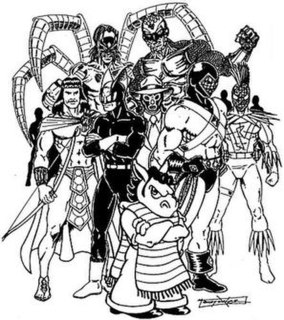
The Professional Amigos of Comic Art Society is a defunct American non-profit organization formed by several independent comic book and cartoon creators in 1995.
Figures from Aztec mythology have appeared many times in works of modern culture.

In Aztec mythology, Creator-gods are the only four Tezcatlipocas, the children of the creator couple Ometecuhtli and Omecihuatl "Lord and Lady of Duality", "Lord and Lady of the Near and the Close", "Father and Mother of the Gods", "Father and Mother of us all", who received the gift of the ability to create other living beings without childbearing. They reside atop a mythical thirteenth heaven Ilhuicatl-Omeyocan "the place of duality".
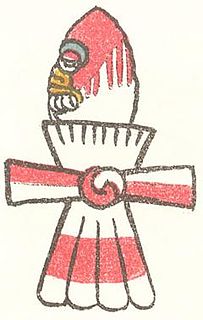
In the Aztec culture, a tecpatl was a flint or obsidian knife with a lanceolate figure and double-edged blade, with elongated ends. Both ends could be rounded or pointed, but other designs were made with a blade attached to a handle. It can be represented with the top half red, reminiscent of the color of blood, in representations of human sacrifice and the rest white, indicating the color of the flint blade.

An ofrenda is a home altar with a collection of objects placed on a ritual display during the annual and traditionally Mexican Día de Muertos celebration. An ofrenda, which may be quite large and elaborate, is usually created for an individual person who has died and is intended to welcome them to the altar setting.

Javier Hernandez is an American artist, comic book creator, and radio host from Whittier, California. Perhaps best known for creating the popular series, El Muerto: The Aztec Zombie, the majority of his works are published through his privately owned imprint, Los Comex.

The CMLL Día de Muertos (2014) was a professional wrestling supercard event, scripted and produced by the Mexican Lucha Libre promotion Consejo Mundial de Lucha Libre (CMLL). The show took place on October 31, 2014 in CMLL's main venue, Arena México, in Mexico City, Mexico and celebrated the Mexican Day of the Dead celebration. Many of the wrestlers working the show wore the traditional Día de Muertos face and body paint for the Día de Muerto event. From the fourth match on the losing wrestlers were be dragged to El Inframundo, a side entrance in the arena, by a group of wrestlers dressed up as minions of the ruler of the underworld.
